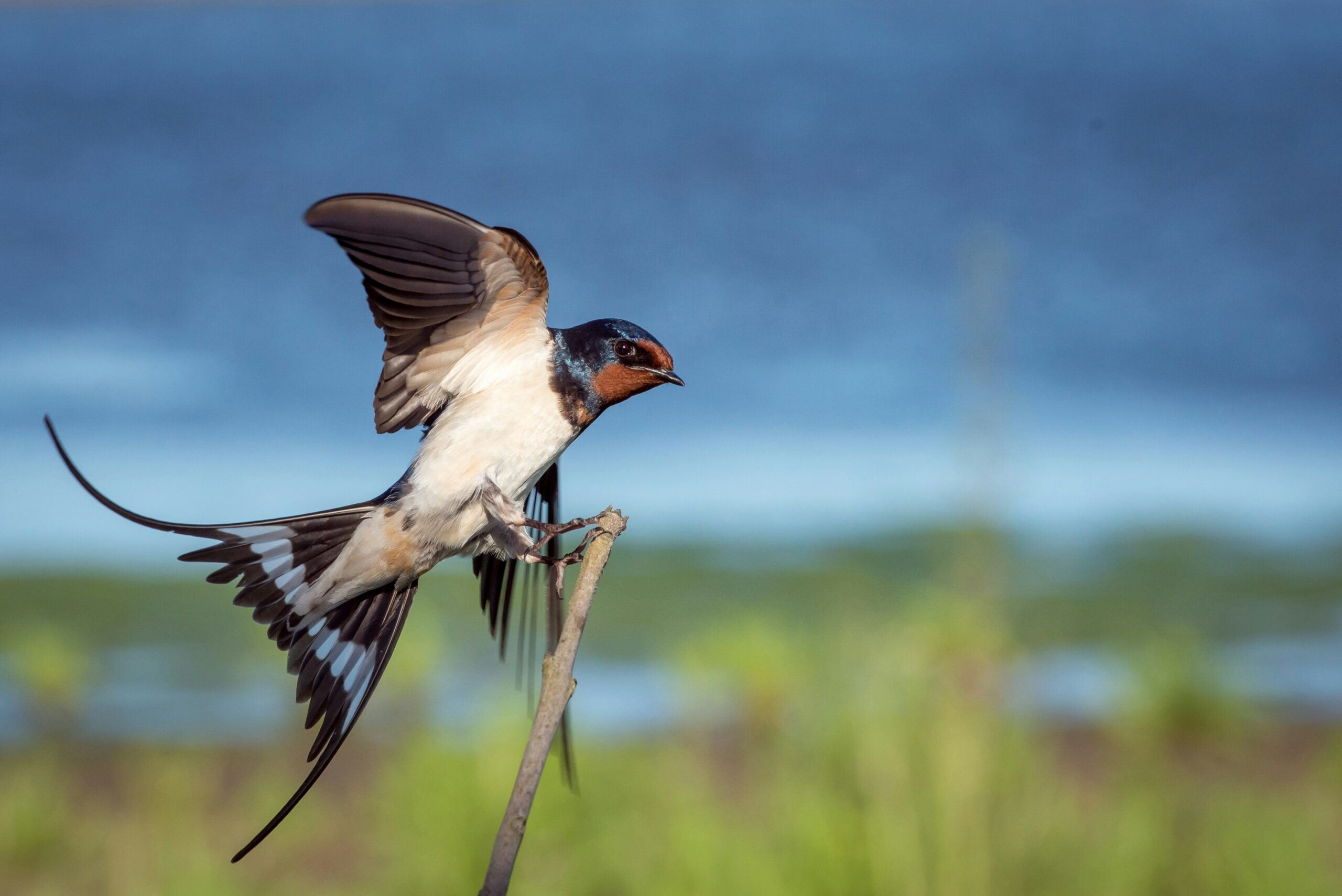Birdwatching is an immensely rewarding hobby, and among the most fascinating avian acrobats are swallows, swifts, and house martins. These three species are often confused due to their similar silhouettes, rapid flight patterns, and preference for catching insects on the wing.
However, each of these birds has distinct characteristics that make identification easier once you know what to look for. This guide will help you tell them apart based on their appearance, flight behavior, nesting habits, and calls.
Physical Characteristics of Swallows, Swifts & House Martins
Swallows (Family: Hirundinidae, Genus: Hirundo)
Swallows are medium-sized birds with a distinctive streamlined body, long pointed wings, and deeply forked tails. The most common species in Europe is the barn swallow (Hirundo rustica), which has:
- A glossy blue-black back
- A creamy-white underside
- A deep red or chestnut forehead and throat
- Long tail streamers (especially in males)
The barn swallow’s long tail feathers are one of its most striking features, and they play a role in mating displays—longer tails are preferred by females. Swallows have a slight iridescence to their plumage, which can shimmer under direct sunlight, making them even more distinguishable.
Swifts (Family: Apodidae, Genus: Apus)
Swifts look superficially similar to swallows but belong to an entirely different family. They are built for an almost entirely aerial lifestyle and possess:
- A stockier body
- Long, sickle-shaped wings
- A sooty brown overall coloration (which can appear black in flight)
- A very short, barely noticeable forked tail
One key identifier is their wing shape—when fully extended, swift wings resemble a crescent moon or boomerang, which is quite different from the narrower, pointed wings of swallows. Additionally, their legs are exceptionally short, which prevents them from perching like swallows or house martins. Instead, they cling to vertical surfaces when they land.
House Martins (Family: Hirundinidae, Genus: Delichon)
House martins are closely related to swallows and share some physical traits, but they are distinctive in their own right. They are characterized by:
- A glossy blue-black upper body
- A pure white underside
- A white rump, which is the best identifying feature
- A shorter, less deeply forked tail compared to swallows
House martins are often seen in flocks, especially near human settlements where they build their nests. They have a slightly plumper appearance compared to swallows, which can make them easier to identify when perched or flying at lower altitudes.
Flight Patterns of Swallows, Swifts & House Martins
Swallows
Swallows have a graceful, fluid flight with frequent gliding between bursts of rapid wingbeats. They tend to fly lower than swifts and house martins, often skimming the surface of fields, rivers, and lakes to catch insects. Their forked tails help them make sharp turns and agile maneuvers in pursuit of prey. Swallows are adept at adjusting their flight speed and direction quickly, making them highly efficient insect hunters.
Swifts
Swifts are the fastest flyers among the three, capable of reaching speeds of up to 70 mph (113 km/h). Their flight is characterized by rapid, continuous wingbeats with minimal gliding. Unlike swallows and house martins, swifts do not perch in the open—they cling to vertical surfaces when resting. They spend almost their entire lives airborne, even drinking, mating, and sleeping while in flight. This makes them unique among the three species and an incredible subject of study.
House Martins
House martins have a more fluttery, erratic flight compared to swallows. They tend to fly higher in the sky, often circling in groups as they hunt for insects. Their wingbeats are more intermittent, with noticeable pauses between flaps. While they lack the sheer speed of swifts, house martins exhibit impressive maneuverability, especially when flying near their nesting colonies.
Nesting Habits of Swallows, Swifts & House Martins
Swallows
Swallows build cup-shaped mud nests, often found in barns, stables, and under bridges. They prefer open, sheltered spaces with easy access to feeding areas. They are highly territorial about their nesting sites and may return to the same location year after year. A swallow’s nest is typically lined with soft materials like feathers to provide insulation and comfort for the chicks.
Swifts
Swifts nest in crevices, holes in buildings, and cliffs. They do not build mud nests like swallows or house martins; instead, they use saliva and small plant materials to create a nest in enclosed spaces. Swifts are unique in that they rarely land, spending almost their entire lives in flight, even sleeping while airborne. Because of this, their nests are often difficult to spot, and their nesting habits are less familiar to casual birdwatchers.
House Martins
House martins construct rounded mud nests under the eaves of houses and buildings. Their nests are completely enclosed except for a small entrance hole. They often nest in colonies, which distinguishes them from swallows, who usually nest in smaller groups or pairs. The communal nature of house martin colonies can result in spectacular displays of social interaction, including cooperative feeding and communal defense against predators.
Migration and Seasonal Differences Between Swallows, Swifts & House Martins
All three species are migratory, traveling vast distances between breeding and wintering grounds.
- Swallows migrate from Europe to sub-Saharan Africa for the winter, typically returning in spring.
- Swifts also winter in Africa but arrive in Europe slightly later in spring and depart earlier than swallows and house martins.
- House Martins follow a similar migration route to swallows but tend to leave a little later in autumn.
A fascinating aspect of their migration is their ability to navigate thousands of miles using celestial cues, the Earth’s magnetic field, and even visual landmarks. Their endurance and precision in migration are remarkable feats of nature.
Conclusion
With practice and careful observation, it becomes easier to differentiate swallows, swifts, and house martins. Swallows are the most elegant with their long tail streamers, swifts are the fastest with their crescent-shaped wings and nonstop flight, and house martins are the easiest to identify due to their bright white rump. By paying attention to their flight patterns, nesting sites, and calls, bird enthusiasts can confidently tell these three species apart and enjoy their remarkable aerial displays. Understanding their habits, from migration to nesting, enhances the appreciation of their role in the ecosystem and the wonder of their long journeys across continents.

